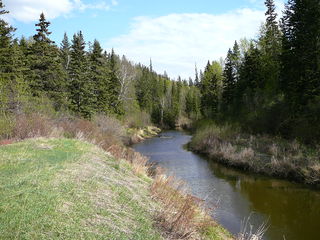Haddow is a triangle-shaped residential neighbourhood in south west Edmonton, Alberta, Canada. It is bounded on the south west by Anthony Henday Drive and on the south east by Terwillegar Drive. The northern boundary is an undeveloped strip of land about 29 Avenue.
Carter Crest is a triangle-shaped residential neighbourhood in south west Edmonton, Alberta, Canada. It is bounded on the north west by Terwillegar Drive, on the north east by Rabbit Hill Road, and on the south by a utility corridor located just north of 29 Avenue.

Whitemud Creek is a tributary of the North Saskatchewan River in central Alberta, Canada.
Bulyea Heights is a residential neighbourhood in the Riverbend area of south west Edmonton, Alberta, Canada. The neighbourhood overlooks Whitemud Creek Ravine. The neighbourhood is named for George H. V. Bulyea, first Lieutenant-Governor of the Province of Alberta.
The Meadows is a residential district in the city of Edmonton, Alberta, Canada. Located in southeast Edmonton, the Meadows is bounded by Whitemud Drive to the north, 34 Street to the west, and Anthony Henday Drive to the east and south. The residential district of Mill Woods is immediately west of the Meadows across 34 Street, while Strathcona County is located to the east across Anthony Henday Drive.
Terwillegar Drive is a developing freeway in south-west Edmonton, Alberta. It is under construction, with the majority of its intersection at-grade, it retains its arterial road status. Once completed, it will be the third freeway in Edmonton not to have a highway designation after Groat Road and Wayne Gretzky Drive. South of Windermere Boulevard the roadway goes by 170 Street SW.
South Terwillegar is a neighbourhood in southwest Edmonton, Alberta, Canada that was established in 2003 through the adoption of the South Terwillegar Neighbourhood Area Structure Plan (NASP).
Castle Downs is a residential area in the northwest portion of the City of Edmonton in Alberta, Canada. The area was originally to be called Athabasca Downs, but when the city rejected the name, the developer used their second choice: Castle Downs. The names of the communities were based on European castles, and Castle Downs became the first area in Edmonton to be named in a thematic way. According to former Names Committee secretary Nancy Diettrich “The castles were chosen to recognize the different ethnic groups in the area.” It was originally established in 1971 through Edmonton City Council's adoption of the Castle Downs Outline Plan, and then extended northward in 1983 through the adoption of the Caste Downs Extension Area Structure Plan. Combined, these two plans guide the overall development of the area.
Pilot Sound is a residential area in the northeast portion of the City of Edmonton in Alberta, Canada. It was established in 1981 through Edmonton City Council's adoption of the Pilot Sound Area Structure Plan, which guides the overall development of the area.
Lake District or Edmonton North is a residential area in the northeast portion of the City of Edmonton in Alberta, Canada. It was established in 1979 through Edmonton City Council's adoption of the Edmonton North Area Structure Plan, which guides the overall development of the area.
The Palisades is a residential area in the northwest portion of the City of Edmonton in Alberta, Canada. It was established in 1984 through Edmonton City Council's adoption of the Palisades Area Structure Plan, which guides the overall development of the area.
Lewis Farms or Lewis Estates is a residential area in the west portion of the City of Edmonton in Alberta, Canada. It was established in 1988 through Edmonton City Council's adoption of the Lewis Farms Area Structure Plan, which guides the overall development of the area.
The Grange is a residential area in the west portion of the City of Edmonton in Alberta, Canada. It was established in 1998 through Edmonton City Council's adoption of The Grange Area Structure Plan, which guides the overall development of the area.
West Jasper Place is a residential area in the west portion of the City of Edmonton in Alberta, Canada. It was established in 1972 through Edmonton City Council's adoption of West Jasper Place Outline Plan, which guides the overall development of the area.
Southeast Edmonton is a residential area in the southeast portion of the City of Edmonton in Alberta, Canada. It was established in 2005 through Edmonton City Council's adoption of the Southeast Area Structure Plan, which guides the overall development of the area.
Ellerslie is an area in the southeast portion of the City of Edmonton in Alberta, Canada. It was established in 1999 through Edmonton City Council's adoption of the Ellerslie Area Structure Plan, which guides the overall development of predominantly residential neighbourhoods in the area. While City of Edmonton documents note that there are diverse stories related to Scottish settlers introducing the name Ellerslie, it is known that the name was applied to the local school district by 1895, and to the local post office in 1896, when it was still a rural area many kilometres south of the early boundaries of the recently (1892) incorporated Town of Edmonton.
Heritage Valley is a residential area in the southwest portion of the City of Edmonton in Alberta, Canada. It was established in 2001 through Edmonton City Council's adoption of the Heritage Valley Servicing Concept Design Brief, which guides the overall development of the area. The theme of neighbourhood names within Heritage Valley is "Edmontonians of the Century".
Windermere is a residential area in the southwest portion of the City of Edmonton in Alberta, Canada. It was established in 2004 through Edmonton City Council's adoption of the Windermere Area Structure Plan, which guides the overall development of the area.
Terwillegar Heights is a residential area in the southwest portion of the City of Edmonton in Alberta, Canada. It was established in 1992 through Edmonton City Council's adoption of the Terwillegar Heights Servicing Concept Design Brief, which guides the overall development of the area.

